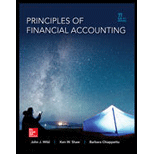
Prepare the
Explanation of Solution
Statement of cash flows: Statement of cash flows reports all the cash transactions which are responsible for inflow and outflow of cash and result of these transactions is reported as ending balance of cash at the end of reported period. Statement of cash flows includes the changes in cash balance due to operating, investing, and financing activities.
Cash flows from operating activities: Cash flows from operating activity represent the net cash flows from the general operation of the business by comparing the cash receipt and cash payments.
Direct method: The direct method uses the cash basis of accounting for the preparation of the statement of cash flows. It takes into account those revenues and expenses for which cash is either received or paid.
The below table shows the way of calculation of cash flows from operating activities using direct method:
| Cash flows from operating activities (Direct method) |
| Add: Cash receipts. |
| Cash receipt from customer |
| Less: Cash payments: |
| To supplier |
| Interest expense |
| For operating expenses |
| Income tax expenses |
| Net cash provided from or used by operating activities |
Table (1)
The cash flows from operating activities section for the year 2015:
| S Company | ||
| Statement of Cash Flows (partial)-Direct Method | ||
| For the Year Ended December 31, 2015 | ||
| Details | Amount ($) | Amount ($) |
| Cash flows from operating activities: | ||
| Receipts: | ||
| Collections from customers | 155,400 | |
| Total cash receipts | 155,400 | |
| Payments: | ||
| Cash payments to suppliers | (72,080) | |
| Cash payments for salaries | (19,700) | |
| Cash payments for rent | (4,900) | |
| Cash payments for insurance | (2,560) | |
| Cash payments for utilities | (1,800) | |
| Cash payments for interest | (2,400) | |
| Total cash payments | (103,440) | |
| Net cash provided by operating activities | $51,960 | |
Table (2)
Working notes:
The amount of cash receipts from customers.
Step 1: Calculate the change in
Step 2: The Calculate the amount of cash receipts from customers.
Calculate the cash payments to suppliers.
Step 1: Calculate the change in inventory.
Step 2: Calculate the change in accounts payable.
Step 3: Calculate the amount of cash payments to suppliers.
Calculate the amount of cash paid for salaries expenses:
Step 1: Calculate the change in salaries payable.
Step 2: Calculate the amount of cash paid for income taxes.
Calculate the amount of cash paid for rent expenses:
Step 1: Calculate the change in prepaid rent.
Step 2: Calculate the amount of cash paid for rent expenses.
Calculate the amount of cash paid for insurance expenses:
Step 1: Calculate the change in prepaid insurance.
Step 2: Calculate the amount of cash paid for insurance expenses.
Calculate the amount of cash paid for utilities expenses:
Step 1: Calculate the change in utilities payable.
Step 2: Calculate the amount of cash paid for utilities expense.
Want to see more full solutions like this?
Chapter 16 Solutions
Principles of Financial Accounting.
- Can you solve this general accounting problem with appropriate steps and explanations?arrow_forwardI am trying to find the accurate solution to this general accounting problem with the correct explanation.arrow_forward← Week 1: Homework Question 3 of 4 8.75/10 The project is completed in 2025, and a successful patent is obtained. The R&D costs to complete the project are $113,000. The administrative and legal expenses incurred in obtaining patent number 472-1001-84 in 2025 total $16,000. The patent has an expected useful life of 5 years. Record the costs for 2025 in journal entry form. Also, record patent amortization (full year) in 2025. (Credit account titles are automatically indented when amount is entered. Do not indent manually. If no entry is required, select "No Entry" for the account titles and enter O for the amounts. List all debit entries before credit entries.) Account Titles and Explanation Research and Development Expense Cash (To record research and development costs) Patents Cash (To record legal and administrative costs) Amortization Expense Patents (To record one year's amortization expense) Debit 113000 16000 3200 Credit 113000 16000 3200arrow_forward
- Joe transfers land to JH Corporation for 90% of the stock in JH Corporation worth $20,000 plus a note payable to Joe in the amount of $40,000 and the assumption by JH Corporation of a mortgage on the land in the amount of $100,000. The land, which has a basis to Joe of $70,000, is worth $160,000. a. Joe will have a recognized gain on the transfer of $90,000. b. Joe will have a recognized gain on the transfer of $30,000.c. JH Corporation will have a basis in the land transferred by Joe of $70,000. d. JH Corporation will have a basis in the land transferred by Joe of $160,000. e. None of the above.arrow_forwardPlease provide the correct answer to this general accounting problem using accurate calculations.arrow_forwardCan you solve this general accounting question with accurate accounting calculations?arrow_forward

 AccountingAccountingISBN:9781337272094Author:WARREN, Carl S., Reeve, James M., Duchac, Jonathan E.Publisher:Cengage Learning,
AccountingAccountingISBN:9781337272094Author:WARREN, Carl S., Reeve, James M., Duchac, Jonathan E.Publisher:Cengage Learning, Accounting Information SystemsAccountingISBN:9781337619202Author:Hall, James A.Publisher:Cengage Learning,
Accounting Information SystemsAccountingISBN:9781337619202Author:Hall, James A.Publisher:Cengage Learning, Horngren's Cost Accounting: A Managerial Emphasis...AccountingISBN:9780134475585Author:Srikant M. Datar, Madhav V. RajanPublisher:PEARSON
Horngren's Cost Accounting: A Managerial Emphasis...AccountingISBN:9780134475585Author:Srikant M. Datar, Madhav V. RajanPublisher:PEARSON Intermediate AccountingAccountingISBN:9781259722660Author:J. David Spiceland, Mark W. Nelson, Wayne M ThomasPublisher:McGraw-Hill Education
Intermediate AccountingAccountingISBN:9781259722660Author:J. David Spiceland, Mark W. Nelson, Wayne M ThomasPublisher:McGraw-Hill Education Financial and Managerial AccountingAccountingISBN:9781259726705Author:John J Wild, Ken W. Shaw, Barbara Chiappetta Fundamental Accounting PrinciplesPublisher:McGraw-Hill Education
Financial and Managerial AccountingAccountingISBN:9781259726705Author:John J Wild, Ken W. Shaw, Barbara Chiappetta Fundamental Accounting PrinciplesPublisher:McGraw-Hill Education





